What’s the Gaucho Culture?
What does gaucho mean? What’s the history of the Argentine Gaucho? What does gaucho symbolize in Argentina? What were the gaucho beliefs? What’s the “Gaucho Style”?
Here, you’ll hear the story of men who knew no other law or justice than his and his people’s. Of those who lived free in the land and with what land gave them. Of those who made it to the history books.
What’s a Gaucho?
Gauchos were inhabitants of the Pampean plains of Argentina. They were known for their independence, self-sufficiency, and coexistence with the land. To this day they remain a symbol of Argentine culture, forming an essential part of the country’s history.
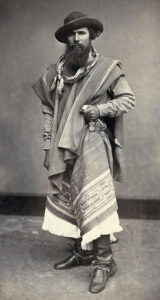
Origin Denomination
But, what does gaucho mean in Argentina? The word “gaucho” has different etymologies. Perhaps the most widespread is that of Quechua origin “huachu”, which means orphan, vagabond. This is consistent with his fame as a nomad, as well as his origin story.
Their presence had to do with the “maroon” cattle. These cattle were called in this way for having escaped from the corrals or simply for remaining in the wild. By then, the Pampas plains were flooded with homeless and ownerless cows and horses.
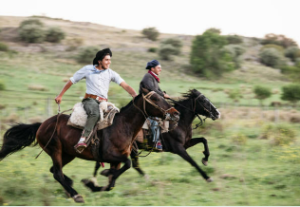
In this desert place, with these wild and free beings, those who would later be called gauchos found their place. They understood that in these fields they could subsist without much effort, since they believed that with that nobody’s cattle they could calmly satisfy their sustenance needs. Everything was provided by nature, and nothing more than that was needed. If they required food, for example, they hunted an animal. In a way, it’s said that their tasks and lifestyle was pretty similar to the North American Cowboy.
In this way, the image of the independent gaucho who seeks freedom begins to consolidate. No job or permanent home. A man who crosses the earth on horseback and sleeps in the open field under the stars of the night firmament. Taciturn and ready for what life will bring.
Popular Denomination
It is then, at the end of the 17th century, that the authorities give permission to the owners of the land to carry out “vaquerías”. This implied collecting and slaughtering the wild cattle. Therefore, the gaucho began to work for these landowners. At the same time, due to the expeditions that required the search for cattle, they move further and further away from populated urban centers and spread throughout the pampas.
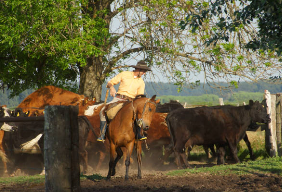
The denomination “gaucho” began to be used regularly in the last decades of the 18th century, denominating a certain independent and rebellious rural type of Creole origin, who did not obey or accept the social and work routines imposed by the authorities.
They formed the group of the first countrymen who founded a peasant society.
The Legend
Do you know who the “first gaucho” is? According to a legend, in the Buenos Aires of 1586 lived an Andalusian soldier named Alejo Godoy. He complained about the bad treatment and the terrible living conditions.
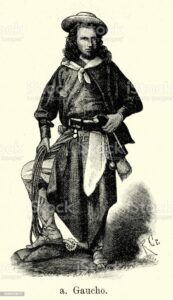
In his legend, he would have sent a letter to the King of Spain to attend to his condition and those of his companions who were in similar conditions. Not receiving an answer from the King (as one would suppose), he went out into the square in a rage to shout “Death to Felipe II!”. Then, he galloped off into the field.
This story is almost certainly legendary, but like many legends, it brings us closer to our own history. And our history, brings us closer to our selfs.
What were the beliefs of the gaucho?
The gaucho plays an important symbolic role in shaping national sentiment and the idiosyncrasy of the region. Especially in the Río de la Plata area (Argentina and Uruguay).
The Martín Fierro
In scripture, he is often described as a man with long, jet-black hair. His face black from wind and sun. Hat, trousers, boots made of cowhide. A gleaming knife on the belt. With a diet based on roast beef, accompanied by Mate
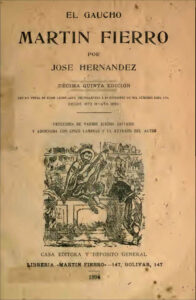
(still don’t know what mate is? Check out our latest post on the subject) or some tobacco cigar.
The most famous work of the gaucho literature genre is The Martín Fierro, by José Hernández. This text finishes placing the gaucho as a symbol of Argentine national tradition, contrasting it with the Europeanizing tendencies of the city and the corruption of the justice of the city’s political class.
First of all, this work responds to a very particular historical context. It was written in the beginning of The Conquest of the Desert. The campaign consisted of wipping off the native american poblers from the territory, taking their grounds as foundations to what whe know today as Patagonia Argentina.
Many gauchos were forcibly incorporated into the national army. This is what happens to Martín Fierro at the beginning of the poem. But our hero opposes going to war against “the Indian” and deserts. Choose to become a fugitive from the law. Hence the gaucho owner of himself, slave of no one.
Philosophy
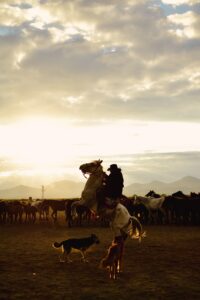
As we mentioned before, the gaucho lives a life rich in values and austere in goods. It uses the essentials to survive in nature, since everything that it provides will be more than enough. The Horse is it’s ally, took as transport and company, and a back protection in the event of getting tangled in a duel. The Poncho and the rest of the typical clothing is used for the cold and the rain, to take shelter in the open air and sleep. The Facón is the instrument of work, food and defense.
Knives where an important aspect of their culture. Not only they use them, but the crafted them, giving for result an extention of their body and will. Used for facing adversities and making asado, this knives had a versatile use. (You can read more about them in our post, How many types of Knives are there?)
The Gaucho represents the values of honor, freedom and courage. He was hospitable and loyal. Silent and fierce. It symbolizes a man who will not hesitate to fight for what he considers fair for himself or for his loved ones. Armed with courage, he faces being tamed by a city that does not respect. That he is independent and fends for himself, looking for freedom beyond the fields, riding tirelessly.
Asado
A topic appart that deserves a separate post, is the Asado. But we couldn’t hold back ourselvs from mentioning it (we are Argentinian, after all). Similar to and absolutely different from the northamerican Barbecue, it’s a preparation with beef as the main course.
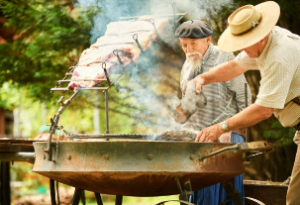
Beyond that, the Argentine Asado, which today is internationally acclaimed and recognized, has a humble origin. It dates back to the gauchos’ need to survive. They used to coock the least wanted cuts of meat on the market, since they were the ones they couldn’t sell as nobody would eat them for it’s poor quality. For this reason, they decided to cook it over coals and firewood, cooking it a longer amount of time in order to bring out the soft and tender point, of that meat covered in fat and consistent of bone.
Like the moment of the Mate round, the Asado had a value beyond food. It’s to this day a gastronomic ritual. One where the “asador” uses the most special Grill tools. and Grill and Carving Sets. It’s a liturgical act that connects family or friends around the fire, just enjoying the moment of a simple but delicious meal.
Where there any Female Gauchos?
Yes! She was known as “China”, “Huayna” or “Paisana”. They were women with deep eyes, dark as the night though some had them blue as the day. They had straight and long dark hair, which they used to tie up in one or two braids. Unlike the gaucho, she was friendly and courteous, distinguished by her friendliness and sweetness. They complemented her mate’s fierce personality, but she rode side by side with him.
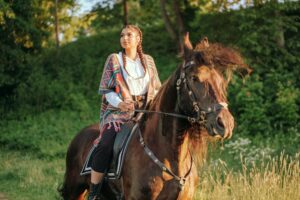
The china used to live with the gaucho, marked by his long absence, which she accepted and knew how to accept with wisdom and patience. She stayied occupied with agriculture and domestic chores.
She used to take care of the ranch and the children. Knitted and sewed clothes. Took care of the corral of chickens, pigs and horses. Tilled the land and cultivated the garden. She used to harvest mainly corn, squash, onion, tobacco, potatoes and take care of the occasional fruit tree. Although the gaucho was in charge of the Asado, she was the mind and the hands behind everything else: the carbonada, the stew and the locro, or the fried cakes, the sweets and mazamorra.
The presence of the china was essential for the gaucho, bringing balance to his life.
Pulpería Tavern
When “Pulperías” appeared is still in doubt, but what pulperías are, everyone around here knows. It was a typical store from the different Spanish American regions, from Central America to the Southern Cone, which provided customers with essential products of daily life.
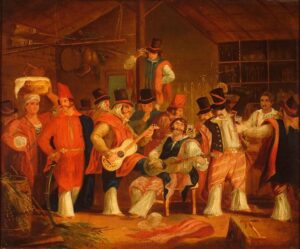
Business was done there, but not only. People also used to meet in these stores as taverns to chat, have a drink, watch cockfights, play dice or cards, and find out what’s new. Tables and chairs were always available for the inhabitants, who enjoyed this place as a true meeting point.
In Argentina, these establishments were a vibrant expression of the local culture. In the case of the Río de la Plata region, there was always one or two guitars, so that the gauchos could play and sing. There were often dances and “payadas” among the gauchos. A payada, by the way, is a musical poetic art in which a person, the “payador”, improvises a rhyming recitation accompanied by a guitar.
To ilustrate it in the words of Charles Darwin, who spent two months in the region in 1832:
At night we stopped at a pulperia, or drinking-shop. During the evening a great number of Gauchos came in to drink spirits and smoke cigars: their appearance is very striking; they are generally tall and handsome, but with a proud and dissolute expression of countenance (…) Their politeness is excessive; they never drink their spirits without expecting you to taste it; but whilst making their exceedingly graceful bow, they seem quite as ready, if occasion offered, to cut your throat.
Impact on Argentine history
The gauchos played a fundamental role during the Argentine War of Independence, between 1810 and 1825. After the First Junta emerged in Buenos Aires, it was gauchos who followed the caudillo José Gervasio Artigas.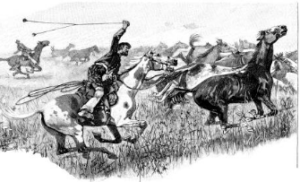
Many gauchos held up an ideology that mixed the contents of the French Enlightenment and the independence of the United States, rather than the political and cultural legacy of the Spanish lands. The gauchos, along with the indigenous and other peasants, helped to establish the first federal government in the region of the Río de la Plata, forming the Union of Free Peoples within the United Provinces of the Río de la Plata, more appropriately a group of confederated provinces outside the centralism of Buenos Aires.
Over time, this events would become an important insignia in the shaping of national sentiment and the history of the region. They bequeathed habits and values that lasted to this day.
Are there any Gauchos today?

In modern times, the role and lifestyle of gauchos have changed significantly due to urbanization, industrialization, and changes in the agricultural industry. However, some aspects of gaucho culture and traditions persist, and there are still individuals who identify as gauchos and engage in related activities.
The rural population play a vital role in promoting and preserving traditional gaucho culture. They participate in cultural festivals, exhibitions, and rodeos, showcasing their horsemanship skills, traditional attire, and folkloric music and dance.
They also take care of cattle and breeding horses. In rural areas, some gauchos continue to work on cattle ranches, where they assist with cattle herding, branding, and general ranch maintenance. Some gauchos also specialize in horse breeding and training, particularly for specific equestrian disciplines such as polo.
Gauchos are known for their craftsmanship and the production of traditional leatherwork, including saddles, belts, and boots. Some gauchos continue to practice these artisanal skills, preserving traditional techniques and creating handmade products.
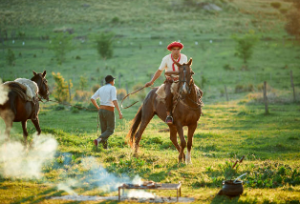
They are in the plains, living off of cattle and cultives. And they are also in the city, were they changed their horse for a car and their communication for a cellphone. But the Gauchos, rural or urban, will always maintain up high their values, culture and tradition.
Why we are here
In Pampa’s Way, we like to keep it simple. From the begining, we believed that putting heart and effort in everything we do would take us far. And so, we do things by ourselves and our way… sound familiar?
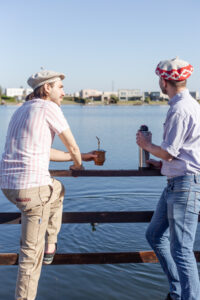
Starting with only passion and will, after 10 years in the business we became experts in our field. We specialize in Knives, forged in Damascus Steel and Stainless Steel, resulting in Steak Knives, Nickel Silver and Carved Handles. We also provide all type of accesories for making Asado and carrying a lifestyle according to the Gaucho Style, adapting it to our present tendecies and necesities.
That’s why we take the best artesians of the country, specialized in gaucho culture, and work with them side by side to give you the best handmade products. We make pieces that embodie that freedom, bravery and adventure that the gauchos had, and ship them all over the world.
The products we give you are the horses we ride, that carry us to new lands to spread the Gaucho philosophy.
Bonus! Recommendation from your friends of Pampa’s
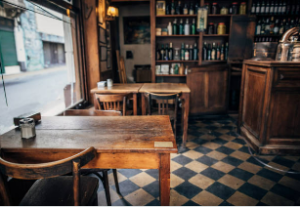
Here we leave you with some pulperías that still open and recibing costumers near the center of Buenos Aires:
96 miles from the center of Buenos Aires, on the shore of the Luján River, lays a rustic house with an Argentinian flag flaming on top. There’s set the Pulpería de Cacho, and one of the mosts codicieted fried empanada’s recipies in the country. Empanadas go about a fried dough in the shape of a crescent, typically filled with shredded or knife-cut beef marinated in sauce with onion and condiments. You can also try cheese and charcuterie platters, and assist to dances and asados.
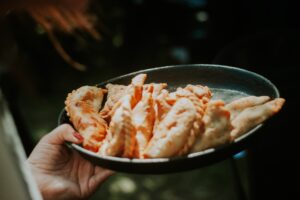
This place is in San Telmo, the heart of Buenos Aire’s City. It was a colonial house for 11 families, then a tenement house and later a dry cleaner’s. Even modest a mechanical workshop! The Quilapán grocery store has been operating since 2012.
A team of archaeologists participated in the restoration of the property, with a project that tried to go back to the original plans of the 19th century house, giving back to the block its green lung, its history and its colonial style. So here, you can know more about archaeological discoveries while you enjoy the typical Creole cuisine!
Located in Chenaut, Buenos Aires. It’s a modern day pulpería, with more enfasis in the restaurant area and a young crew at the head of it. It’s an example of what the past leave us and what we can do with it. Filled with new hopes and vintage decorations, here, you can get picadas with charcuterie from the area, asado, empanadas or pasta while drinking craft beer and a good wine. It’s a place with a view, where sunsets are unforgetable.